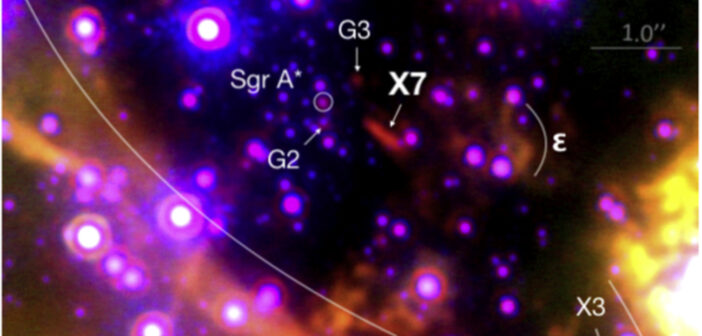Editor’s Note: In these last two weeks of 2023, we’ll be looking at a few selections that we haven’t yet discussed on AAS Nova from among the most-downloaded articles published in AAS journals this year. The usual posting schedule will resume in January.
The Swansong of the Galactic Center Source X7: An Extreme Example of Tidal Evolution near the Supermassive Black Hole
Published February 2023
Main takeaway:
Using two decades of observations, a team led by Anna Ciurlo (University of California, Los Angeles) characterized a galactic center source called X7, a cloud of gas and dust found near the Milky Way’s supermassive black hole. Over time, the cloud has become dramatically elongated, which the authors attribute to tidal forces from the black hole. While the origins and age of the cloud are uncertain, the authors propose that it is the gas ejected in a glancing collision between stars in a binary system.Why it’s interesting:
The neighborhood surrounding a supermassive black hole is an exciting place: tightly packed stars undergo collisions or near misses, and some even get tidally shredded by the black hole itself. This dynamic environment changes considerably on short timescales, and not just in the astronomical sense — the stars closest to the Milky Way’s central supermassive black hole take scarcely longer than a decade to complete their orbits. Unlike other dusty objects in its neighborhood, like the “G” objects labeled in the header image above, X7 doesn’t appear to be bound to a star and instead looks to be a 50-Earth-mass blob of dusty gas roaming the galactic center.
More details on X7 and its possible age and origin:
The rapid stretching of X7 over the past two decades suggests that the cloud is unlikely to remain intact as it nears the Milky Way’s supermassive black hole. This sets an expiration date for the cloud of 2036, when it will make its closest approach, and it also sets a maximum age for the cloud of around 200 years, given its orbital period. X7 is likely the result of a recent event, then, and the similarity between the orbits of the tip of the X7 gas cloud and a dusty stellar source called G3 raises the intriguing possibility that X7 was ejected when G3 was created in a stellar merger.
Citation
Anna Ciurlo et al 2023 ApJ 944 136. doi:10.3847/1538-4357/acb344


